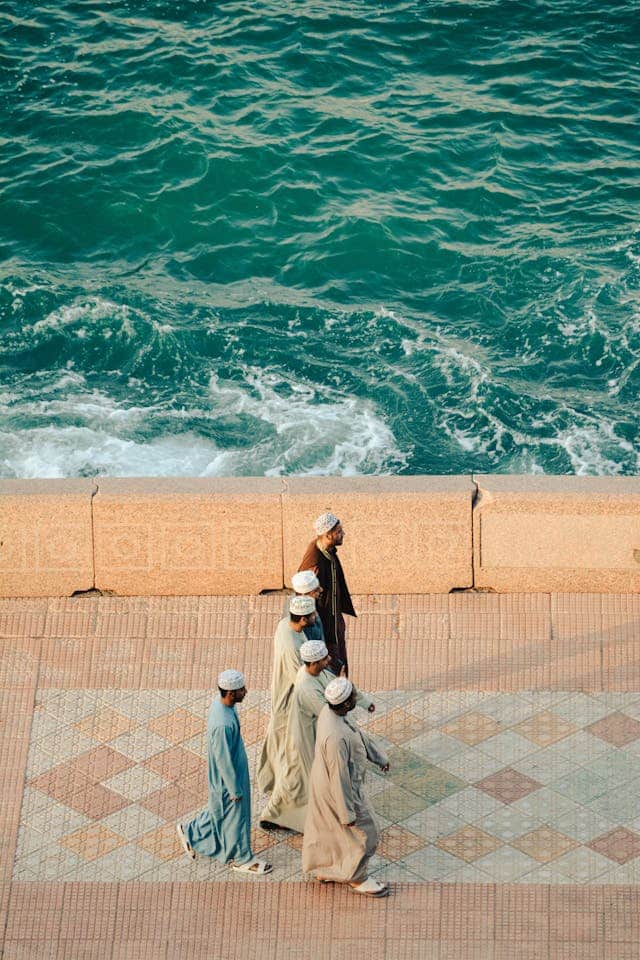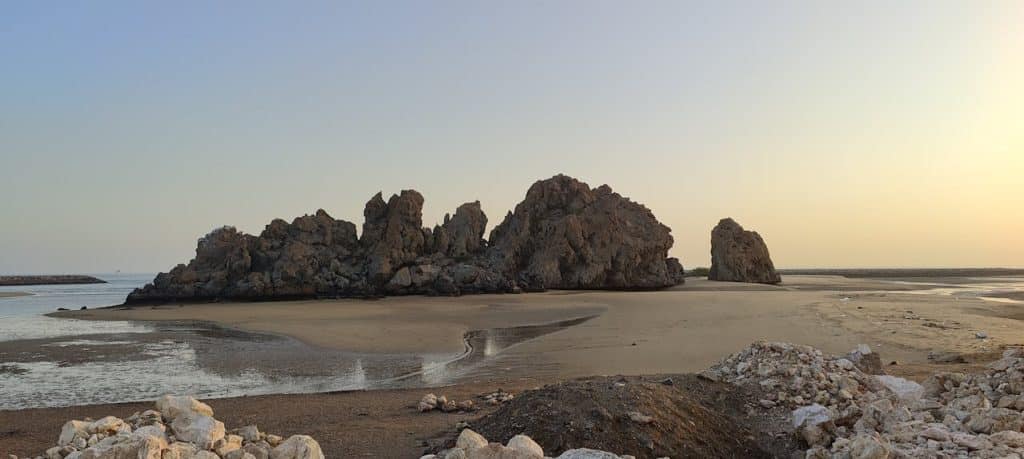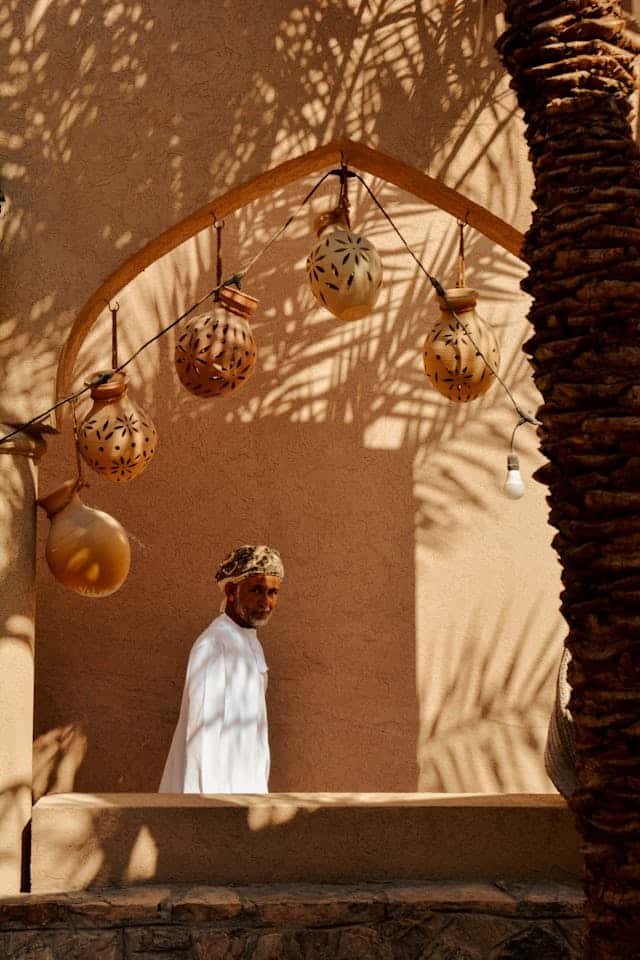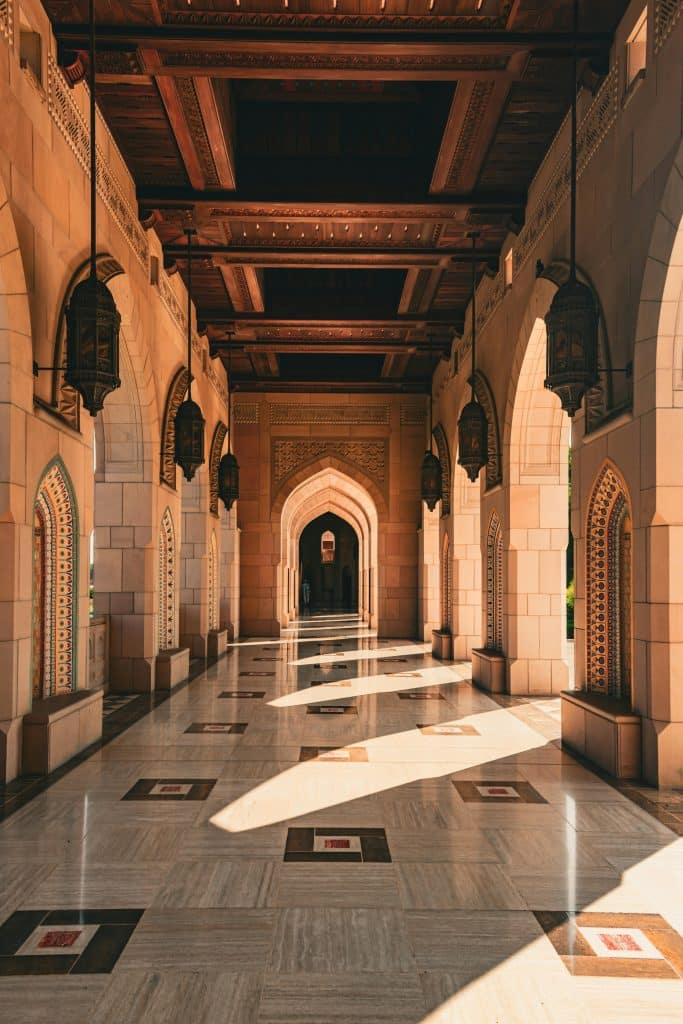
Situated between the rugged Hajar Mountains and the calm waters of the Arabian Sea, Muscat is the capital and largest city of Oman. It sits along the Gulf of Oman and offers a striking blend of natural beauty and urban charm. As of 2025, the city is home to an estimated 1.7 million people.
Unlike the towering skylines of Dubai or Doha, Muscat holds onto a quieter, more traditional rhythm. It’s a place where whitewashed buildings, seaside forts, and mountain views come together to shape a unique experience in the Gulf.
This travel guide will show you what sets Muscat apart, from practical tips and must-see locations to the new GCC unified visa that makes visiting even easier. For more news about the GCC visa, read this.
Why Muscat Is Overlooked and Why That’s Good
Muscat often gets passed over in favor of flashier Gulf destinations. Unlike Dubai, Abu Dhabi, and Doha, known for their skyscrapers and luxury shopping malls, Muscat has taken a different path, one that values tradition, quiet beauty, and cultural depth.
Development in the city is carefully regulated, with an emphasis on preserving Omani identity. Low-rise buildings, open coastlines, and mountain backdrops define the skyline, not glass towers.
This lower profile has worked in Muscat’s favor. The city feels more grounded and accessible. You won’t find packed nightclubs or massive crowds, but you will find open roads, uncrowded beaches, and souqs still selling frankincense and handmade crafts. It’s a place where conversations with locals happen naturally, and tourist attractions don’t require waiting in long lines.
Oman’s Vision 2040 is also reshaping the future of travel in the region. The government plans to invest over $51 billion into tourism by 2040, with a focus on luxury stays, eco-resorts, and access to heritage sites. In Muscat, this translates into more boutique hotels and upgraded experiences, all without losing the city’s calm, authentic appeal.

Getting There & Practical Info
Before exploring everything Muscat has to offer, let’s find out what you need to plan your trip and get around with ease.
Airport
Muscat International Airport serves as Oman’s main air hub and features a modern terminal that opened in 2018. Designed to handle about 20 million passengers per year, it was recognized as a “leading new airport” in the same year.
The airport connects Muscat directly with major cities across Europe, Asia, and the Middle East. Oman Air, the national carrier, operates alongside several international airlines to offer convenient global access to the city.
Visas
Oman has made its entry process simple for most visitors. Here’s a quick breakdown of the current visa options:
- Visa-free entry: Citizens from more than countries can stay in Oman for up to 14 days without arranging a visa in advance.
- Visa on arrival: Some countries are eligible for a visa directly upon arrival.
- eVisa: For longer stays or nationalities not covered under visa-free entry, an eVisa can be applied for through the Royal Oman Police (ROP) portal.
- Before traveling: Always check the latest visa updates on the ROP eVisa website or Oman’s Ministry of Foreign Affairs page to confirm requirements for your nationality.
Best Season to Visit Muscat
Muscat’s weather can vary sharply through the year, so it’s worth planning your visit around the seasons:
- Best time to visit: November to March offers mild, pleasant weather with daytime temperatures between 23 °C and 26 °C, ideal for sightseeing and outdoor activities.
- Summer conditions: From May to September, temperatures often rise above 35–40 °C, with dry, dusty winds.
- Rainfall: Rain is rare outside the winter months, so expect mostly dry and sunny conditions year-round.
- Travel tip: Aim for late autumn, winter, or early spring for the most comfortable experience exploring Muscat’s beaches, mountains, and city attractions.
Transport
Getting around Muscat is easy and flexible. Taxis are readily available across the city, including government-operated metered cabs and private drivers. For convenience, locals and tourists often use ride-hailing apps such as Marhaba or OTaxi.
The national transport company, Mwasalat, runs public buses on both city and intercity routes—ideal for those seeking a low-cost travel option. Many visitors, however, prefer renting a car to explore freely.
Roads in and around Muscat are well-paved and maintained, fuel prices are low (about $0.60 per liter), and traffic is generally light outside rush hours. Oman follows right-hand driving rules.
Safety
Oman is widely regarded as one of the safest countries in the region. Serious crime is very rare, and locals are known for their hospitality and helpfulness.
As with any major city, travelers should take normal precautions, such as keeping personal items secure in crowded markets or tourist areas.

Money & Tipping
Here’s what you need to know about money, payments, and tipping while in Muscat:
- Currency: The local currency is the Omani Rial (OMR), with an approximate value of 1 OMR = $2.60 USD or €2.40 EUR.
- ATMs: Easily available in hotels, malls, and major shopping areas across the city.
- Card payments: Credit and debit cards are accepted at most hotels, restaurants, and larger stores.
- Cash use: Smaller cafés, souqs, and markets often prefer cash, so carry small notes for daily expenses.
- Tipping: Not required but appreciated. It’s common to round up taxi fares and leave about 10% in restaurants if service isn’t already included.
- Helpful tip: Keep small change on hand for markets, cafés, and tipping.
New GCC Unified Visa & What It Means for Muscat
The GCC “Grand Tours” Tourist Visa is a new policy that will let travelers visit all six Gulf countries with one visa. This includes Oman, UAE, Saudi Arabia, Qatar, Bahrain, and Kuwait. Instead of applying for separate visas, visitors will be able to use a single, multiple-entry permit across the region.
The visa is expected to allow stays of 30 to 90 days. It will support both single-country and multi-country trips. Travelers will be able to enter and exit member states during the validity period without reapplying. Travelers will be able to apply for the GCC unified visa through an online platform once it becomes available.
As of 2025, the unified visa is set to launch in Q4 as a pilot program. A full rollout is expected soon after. Official sources have not yet confirmed the exact start date or application process.
For Muscat, this visa is a major shift. It removes the visa barrier for travelers moving between Gulf cities. Tourists planning routes like Dubai → Muscat → Doha will no longer face extra paperwork. This makes Muscat more attractive as a stop on regional tours.
Until the unified visa goes live, travelers must follow Oman’s current entry rules. But if you’re planning a Gulf trip in late 2025 or beyond, this new visa could change your entire itinerary.
For more news about the GCC visa, read this.
Top Attractions in Muscat
Muscat blends culture, history, and natural beauty in a way that few Gulf cities can match. The city offers a rich mix of iconic landmarks and quiet, off-the-map places that reflect its deep Omani roots.
Here’s a breakdown of what to see and where to go.
Historic & Cultural Sites
- Sultan Qaboos Grand Mosque
Opened in 2001, this is Oman’s largest mosque and a must-see for its scale and beauty. The white marble prayer hall holds up to 20,000 worshippers and features a 21-tonne handwoven carpet and a 14-meter chandelier. Non-Muslim visitors are welcome outside prayer hours with modest dress.
- Al Jalali & Al Mirani Forts
These 16th-century Portuguese-built forts guard Muscat’s harbor from opposite sides. While Al Jalali (east) is not open to the public, you can visit Al Mirani (west), whose hilltop positions and cannon-lined walls offer iconic views over Old Muscat. They remain key landmarks in the city’s skyline.
- Mutrah Souq & Corniche
The Mutrah Corniche runs about 3 km along the waterfront, with palm trees, fountains, and open views of the harbor. At sunset, the area comes alive with fishermen, walkers, and food stalls. The adjacent Mutrah Souq is one of the oldest markets in the Gulf, known for frankincense, silverware, and textiles. The narrow lanes and active bargaining make it a true Arabian bazaar experience.
- Bait Al Zubair Museum
Located in Muscat’s Old Town, this private museum displays Omani heritage through tribal clothing, traditional weapons, jewelry, and art. Its peaceful courtyard and replica historic homes make it worth a short stop.

Natural & Scenic Highlights
- Coastline & Beaches
Muscat has some of the most relaxed city beaches in the Gulf. Qurum Beach and Shatti Al Qurum offer soft sand, casual cafés, and shaded parks. The Corniche near Mutrah is also great for a morning walk or evening coffee with sea views. Beachfront hotels make access easy for visitors.
- Wadi Day Trips
Wadi Shab, about 90 minutes south of Muscat, is one of the most popular natural escapes. You’ll hike through gorges and palm groves to reach emerald pools and a waterfall hidden in a cave. Nearby Wadi Tiwi offers similar scenery with fewer crowds. Both are great for swimming, but guided tours are recommended for boat crossings and local advice.
- Hajar Mountains
Just an hour’s drive from the city, the Hajar Mountains rise sharply into the sky. Jebel Akhdar and Jebel Shams are the top spots, offering cool air, canyon views, and terraced farms. Rose gardens bloom in spring, and even the lower slopes provide sweeping views of rugged cliffs and remote villages.
- Marine Life & Wildlife
The Gulf of Oman is rich in sea life. Dolphin-watching cruises from Marina Bandar Al Rowdha or Al Mouj are popular, often spotting pods of spinner dolphins. Snorkeling trips are also available. For sea turtle nesting, Ras al-Jinz is the key site, about a 6–7 hour drive from Muscat. Inland, you may see mountain goats in places like Wadi Bani Auf or migratory birds in spring.
Hidden Gems & Offbeat Spots
- Local Neighborhoods
Areas like Al Khuwair and Ruwi offer a more everyday view of Muscat. Small tea stalls, date shops, and spice markets give you a taste of local life. Street art can be found in back alleys, especially near Taiba and parts of Old Town.
- The Wave (Al Mouj)
A newer district with a modern marina, art installations, and international cafés. It’s become a trendy area for both locals and visitors.
- Sunrise Trails & Local Cafés
Trails above Qurum and Ruwi are great for early hikes with city views. Off the tourist trail, you’ll find local cafés like Kadm in Matrah where residents sip kahwa and relax. These small moments give you a real feel for the city.
- Cultural Festivals
If you visit in January or February, check out the Muscat Festival. It features traditional music, dance, crafts, and food from across Oman. It’s one of the best chances to experience local culture up close.
Tips for an Authentic Muscat Experience
Muscat offers a warm and welcoming atmosphere, but to truly enjoy the city, it’s important to understand local customs, daily rhythms, and how to avoid common tourist mistakes. Here are some practical tips to help you navigate the city with respect and confidence.
- Dress & Conduct
Oman is a conservative country. While men can wear shorts and short sleeves in public, women should cover their shoulders and knees. It’s a good idea for women to carry a scarf, especially when visiting mosques. At religious sites, remove your shoes before entering and maintain a modest appearance and respectful behavior.
- Prayer Times & Daily Schedule
Small shops and services often close during the five daily prayers. This is especially noticeable on Friday mornings, the main day of worship. Oman’s work week runs from Sunday to Thursday. On Fridays, many places take a long midday break, so plan your activities around these quiet periods.
- Locals & Language
Omanis are known for their politeness and hospitality. A common greeting is “as-salaam alaikum” (peace be upon you). Learning a few basic Arabic phrases like “shukran” (thank you), is appreciated and shows respect.
- Haggling in Souqs
Bargaining is expected in Muscat’s traditional markets. Sellers usually start with high prices, so aim to negotiate the price down. Keep it friendly and polite, as haggling is a normal part of shopping and should be enjoyable for both sides.
- Avoiding Tourist Traps
Muscat is generally free from scams, but some overpriced tours or souvenir shops exist. Always compare hotel and restaurant menus; some may include a mandatory service charge. In areas like Mutrah, avoid accepting offers from unsolicited guides. If you want a guide, book through a verified company or agree on a price in advance.

FAQs
1. What is the local language, and will I manage without speaking Arabic?
The official language is Arabic, but English is commonly used in Muscat, especially in tourism, hotels, shops, and signage. You can get by without speaking Arabic.
2. Do I need travel insurance for Oman?
It’s recommended. While not always strictly enforced, having travel and health coverage gives extra security in case of emergencies, accidents, or health issues.
3. How long is the visa processing?
For the e-visa, processing usually takes 3–5 business days (though in some cases it may be faster or slower).
4. What documents do I need for the Oman visa/arrival?
Typical requirements include a passport valid for at least six months, a passport-style photo, proof of hotel bookings or stay, and return or onward travel tickets.